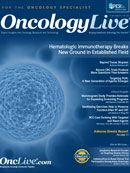Publication
Article
Oncology Live®
Swallowing Exercises Help to Preserve Function After RT and CRT
Author(s):
Head and neck cancer patients who participated in a swallow preservation protocol were less likely to suffer from the detrimental effects associated with dysphagia, a common complication associated with radiation therapy and chemoradiation therapy.
Marilene B. Wang, MD
Professor-in-Residence
Department of Surgery, Head and Neck
UCLA David Geffen School of Medicine Jonsson Comprehensive Cancer Center
Los Angeles, CA
Head and neck cancer patients who participated in a swallow preservation protocol (SPP) were less likely to suffer from the detrimental effects associated with dysphagia, a common complication associated with radiation therapy (RT) and chemoradiation therapy (CRT), according to a recent study.1
Traditional treatments for head and neck cancers involve surgery and RT, but with newer, more targeted chemotherapy options available, many cancer types can be treated with CRT. Because CRT is often more targeted, it is hoped that more tissue and structure can be spared from damage. Unfortunately, preservation does not always translate to normal, natural swallowing ability.
Dysphagia is a main predictor of poor posttreatment quality of life in patients with head and neck cancer, and current clinical interventions to address this symptom in patients undergoing RT and CRT are limited; those that are currently available follow a therapeutic or rehabilitative model rather than a preventive one.
During early radiation treatment, adverse events such as odynophagia, mucositis, or xerostomia can limit the patient’s desire and ability to swallow, and even brief episodes of oropharyngeal rest or lack of exercise during CRT may be associated with prolonged dysphagia.
Marilene B. Wang, MD, professor-in-residence in the Department of Head and Neck Surgery at UCLA’s David Geffen School of Medicine and colleagues, identified 85 patients who underwent RT or CRT at a tertiary care academic medical center from 2007-2012 to participate in the study evaluating whether an SPP implemented before, during, and after RT and CRT could help maintain posttreatment swallow function. Patients were divided into two groups based on self-reported compliance, with compliant defined as performance of at least one full set of exercises per day (n = 57) and noncompliant (n = 28) as performing less than one full set of swallowing exercise per day.
The aim of the program was to maintain range of motion of oral, pharyngeal, and laryngeal structures involved in swallowing and limit the fibrosis associated with radiation that often leads to restricted range of motion resulting in dysphagia, as well as to encourage patients to continue oral intake as much as possible, despite dysgeusia and odynophagia.
As part of the SPP, every patient underwent evaluation by a speech-language pathologist (SLP) prior to treatment. Patient demographic data, primary tumor site, stage of tumor, type of treatment (RT or CRT), radiation dose administered to the primary site, and other relevant information were recorded. Patients used a form to track their swallowing exercises performed and completed, and brought the form to each weekly SPP visit.
Other aspects of the protocol included a pretreatment swallow assessment conducted with patients 2 weeks prior to cancer treatment involving education about their cancer and expected treatment adverse events, assessing for pretreatment dysphagia, as well as introducing the exercise program.
Swallowing exercises were reinforced by the SLP with the aim of increasing adherence and assessing performance. The exercises consisted of gargling liquid for 10 seconds 10 times, effortful swallowing 10 times, performing a Mendelsohn maneuver 10 times, chugging 3 ounces at once, tongue protrusion 10 times, tongue press 10 times, and Shaker head lifts 3 times. These sets were performed 3 times daily (3 sets), except for the Shaker exercise, which was performed once per day (1 set).
One month after completion of therapy, 31 of the compliant patients (54.4%) were eating a regular, chewable diet, versus just 6 in the noncompliant cohort (21.4% [P = .008]). In addition, fewer compliant patients were found to be G-tube dependent (22.8%) compared with 53.6% of those who did not perform the exercises consistently (P = .008).
The real benefit of complying with swallowing exercises before and during RT and CRT, noted researchers, is that the swallowing function is better preserved at the conclusion of therapy and thus, patients benefit immediately from improvement or maintenance of swallowing since they do not have to wait 3 to 12 months after therapy for swallowing potential to return. The authors concluded that compliance with an SPP leads to a faster return to normal diet and prevention of future esophageal stenosis. Larger and longer-term, prospective, randomized studies in the future are needed for assessment of the relationship between swallow preservation therapy and changes in quality of life.
“Our results demonstrate that compliance with swallow therapy during radiation or chemoradiation treatment is beneficial to patients’ retaining their ability to swallow after treatment is over,” said Wang in a statement. “The real benefit of this compliance is that patients benefit immediately after treatment, and for a prolonged time afterward. Attending our weekly program, fully committing to the exercises, and being monitored by our staff appears to have a significantly measurable effect on these patients.”
Reference
- Duarte VM, Chhetri DK, Liu YF, Erman AA, Wang MB. Swallow preservation exercises during chemoradiation therapy maintains swallow function. Otolaryngol Head Neck Surg. Published online ahead of print August 27, 2013.










